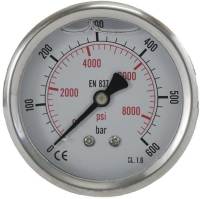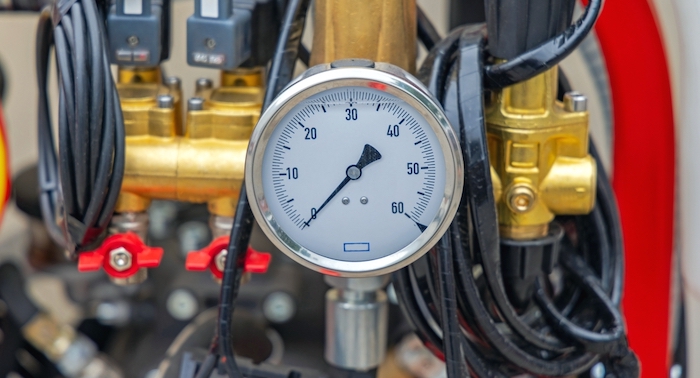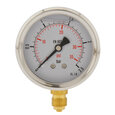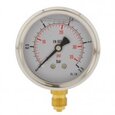Liquid Filled Pressure Gauge

Figure 1: A glycerin-filled pressure gauge
A liquid-filled pressure gauge has a liquid-filled case, which helps dampen vibration and pulsations on the gauge dial allowing for more stable and accurate readings. They are capable of measuring the pressure of fluids, gasses, and vapors in industrial and commercial applications.The liquid, typically glycerin or silicone, also helps to protect the gauge's internal components from corrosion and wear, making the gauge more durable and long-lasting. Read our pressure gauge overview article to learn more about gauges in general.
Table of contents
- Types of liquid
- Liquid filled pressure gauge vs dry pressure gauge
- Selection criteria
- Applications
- FAQs
View Tameson's online selection of pressure gauges
Types of liquid
Liquid filled pressure gauges use different types of liquid:
- Glycerin: Glycerin is the most common liquid in a liquid-filled pressure gauge because of the price and vibration dampening at room temperature. These gauges work well between -20 °C and 60 °C (-4 - 140 °F) .
- Silicone: Silicone-filled pressure gauges are applicable for higher temperature ranges. They operate between -40 °C to 140 °C (-40 - 284 °F) .
- Halocarbon: Halocarbon-filled pressure gauges are suitable for systems with oxidizing agents such as oxygen, hydrogen peroxide, and chlorine. They work well at the same temperatures as glycerin filled gauges.
Liquid filled pressure gauge vs dry pressure gauge
| Liquid filled pressure gauge | Dry pressure gauge | |
| Readability | Easy to read. The indicator stabilized against vibrations and pulsations | Difficult to read the measurement on vibrating equipment |
| Wear & tear | Liquid lubrication and reduced motion frequency of the gears and links result in less wear and tear. | Faster wear and tear due to higher motion frequency of parts. |
| Temperature protection | Protected against high-temperature and extreme temperature fluctuations. | High temperatures will damage parts. |
| Condensation | Condensation build-up is not possible. | Condensation builds up in a wet environment, making it difficult to read. Moisture can also damage the parts of the pressure gauge. |
| Corrosive resistance | It is sealed, therefore, resistant to highly corrosive chemical processes such as acids and salt production. | Not sealed and cannot be used in a corrosive environment. |
| Cost | More expensive, cost-saving long-term. | Cheaper alternative but a higher rate of replacement. |
| Performance in extreme conditions | Consistent performance during all conditions. | Inconsistent performance in extreme conditions. |
| Performance in a sub-zero environment | Protected against sub-zero conditions (up to -40 °C). | Condensed moisture will form ice inside the indicator. |
| Indicator speed | Slower indicator speed due to liquid-resistance. | Faster indicator speed. |
Selection criteria
The general selection criteria for fluid filled pressure gauges are mainly identical to dry pressure gauges. However, there are some additional considerations when choosing a liquid filled gauge.
- Type of liquid filling: Glycerin is suitable for vibration protection at room temperature, while silicone oil is common for high-temperature and extreme temperature fluctuation applications. Halocarbon, finally, is suitable for gauges connected to applications with oxidizing agents.
- Necessity versus cost: While fluid filled gauges offer clear advantages over dry pressure gauges, they are often more expensive for the same measurement range. The reduced wear on liquid-filled gauges will offer a cost advantage for long-term use. A liquid-filled gauge is unnecessary if the application doesn't have vibrations, pulsations, condensation concerns, or extreme temperatures. Consider a dry gauge instead.
Liquid pressure gauges may have minor problems, such as leaks from damaged seals and discolored scales and indicators over time. Learn more about choosing the right pressure gauge in our selection guide.
Applications

Figure 2: A liquid filled hydraulic pressure gauge on an agricultural machine.
Liquid filled pressure gauges work well in the following applications:
- Compressor discharge pressure: Liquid filled gauges are used at the compressor discharge due to high temperatures and the vibrations of the air compressor. Occasionally, using a liquid-filled pressure gauge alone is not enough for these conditions, and a pressure snubber is also necessary.
- Hydraulic pressure gauge:Hydraulic pressure gauges (Figure 2) are often liquid filled due to high-pressure operations. These gauges are used in applications such as hydraulic pumps, lubrication lines, control systems, and hydraulic presses.
- Dust, wet air, or condensation conditions: Liquid filled gauges are used in applications where the gauge is exposed to moist air or water, such as pressure washers. They are sealed and protected against the ingress of dust or moisture, which can affect the internal mechanisms of a dry pressure gauge. Verify the gauge's IP rating.
- Freezing conditions: Fluid pressure gauges are used in refrigeration systems, such as in supermarkets, storage, and medical facilities. Glycerin works to -20°C (-4°F), silicone oil to -40°C.
- Corrosive environment: Liquid filled gauges are suitable in environments with corrosive substances, such as acids in chemical production plants, that can damage the inside mechanisms of the dry pressure gauge. Verify the compatibility of the gauge with our chemical compatibility chart.
FAQs
Are liquid filled gauges better than dry pressure gauges?
Liquid filled gauges are better than dry pressure gauges in conditions with high vibrations, extreme temperatures, and high moisture.







